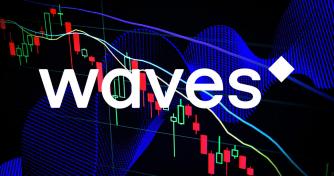 Why some people are saying Waves is a ponzi scheme
Why some people are saying Waves is a ponzi scheme Why some people are saying Waves is a ponzi scheme
Waves price fell from as high as over $60 to around $34 which led to the de-pegging of the Neutrino (USDN) to less than $1.

Cover art/illustration via CryptoSlate. Image includes combined content which may include AI-generated content.
Algorithmic stablecoin pegged to the US dollar, Neutrino has fallen by 15% from its peg and is now worth around 82 cents instead of a dollar.
Neutrino (USDN) is a top ten stablecoin in the market and is backed by Waves token. But the fall in the value of WAVES over the past week means that USDN has also suffered.
This has led to several conspiracy theories regarding the occurrence. While many wonders if WAVES is a Ponzi project, the founder of Waves blockchain has claimed that this was an attempt by FTX-owned Alameda Research to short the WAVES Token.
People should really look at funding rates for WAVES right now 😛
— Sam Trabucco (@AlamedaTrabucco) April 3, 2022
With the falling price, USDN’s market cap dropped to $824.25 million from $960.25 million.
On the other hand, the blockchain network, which has seen its native token perform admirably within the last two months as its value reached as high as $61 by March 31, has plunged to $33 as it has dropped over 20% of its value within the last 24 hours.
The connection between Waves and Neutrino (USDN) decline
The massive drop in the value of both assets has led to questions about whether the claims of the Waves team that the token is overcollateralized are true.
Official data claimed that the backing ratio for the Neutrino smart contract is over 2, which means that there ought to be enough funds to maintain the USDN peg against the dollar at 1:1.
However, a few days earlier, several Twitter accounts accused Waves of manipulating its token price by using Vires.Finance lending platform.
WAVES is the biggest ponzi in crypto
It has recklessly engineered price spikes by borrowing USDC at 35% to buy its own token
Continuous WAVES market cap growth is needed to keep the system stable
WAVES will eventually crash and USDN will break with it
You're on notice🧵
— 0xHamZ (@0xHamz) March 31, 2022
A pseudonymous Twitter analyst explained how the Waves team has been able to do this for the past two months to push its price by 750%.
He stated that Waves have been collateralizing USDN and using it to borrow USDC on Vires.Finance, after which the team uses the proceeds to buy WAVES and repeat the process.
So, is Waves a Ponzi?
While it is undeniable that there is a lot of FUD surrounding the Waves blockchain and USDN, one can’t categorically state that its operation is in the mold of a Ponzi.
Hey guys, let me explain why $USDN will be absolutely fine very soon. Read the thread🧵
— Inal Kardan 🐬 🌊 (1 ➝ 2) (@ikardanoff) April 4, 2022
A Ponzi scheme, according to Wikipedia, is a form of fraud that lures investors and pays profits to earlier investors with funds from more recent investors.
Presently, users have had no issues with withdrawing their funds from the blockchain, and the team proposed to temporarily reduce the liquidation threshold for Waves and USDN borrowing and limit the maximum borrow APR.
Get your popcorn ready: @AlamedaResearch manipulates $waves price and organizes FUD campaigns to trigger panic selling.
I hope I caught your attention. Follow me.
— Sasha Ivanov 🌊 (1 ➝ 2) (@sasha35625) April 3, 2022
This proposal has, however, been kicked against as many have labeled it to be a rug pull attempt.
What does this mean for other algorithmic stablecoins?
Stablecoins play an important role in the crypto industry as traders can use digital assets to save themselves from the wild, volatile nature of the market.
While some popular ones have their reserves in Dollars, others, like Terra’s UST, are algorithmic stablecoins. This type of stablecoin maintains its peg using software and rules only —presently, most of them rely on issuing and burning tokens to maintain the peg.
Notably, Neutrino is not the first dollar-pegged algorithmic stablecoin to lose its peg. Last year, Iron Finance, which was a similar project, failed.
This has led to questions of if the market is ready for algorithmic stablecoins.
The reality of this might be what is currently influencing Terra to back its UST stablecoin with Bitcoin and not just LUNA.
Thus, if LUNA’s price should fall, UST is still able to maintain its value as Bitcoin is also being used as its reserve asset.



 CoinGlass
CoinGlass 


 Farside Investors
Farside Investors 
























































































